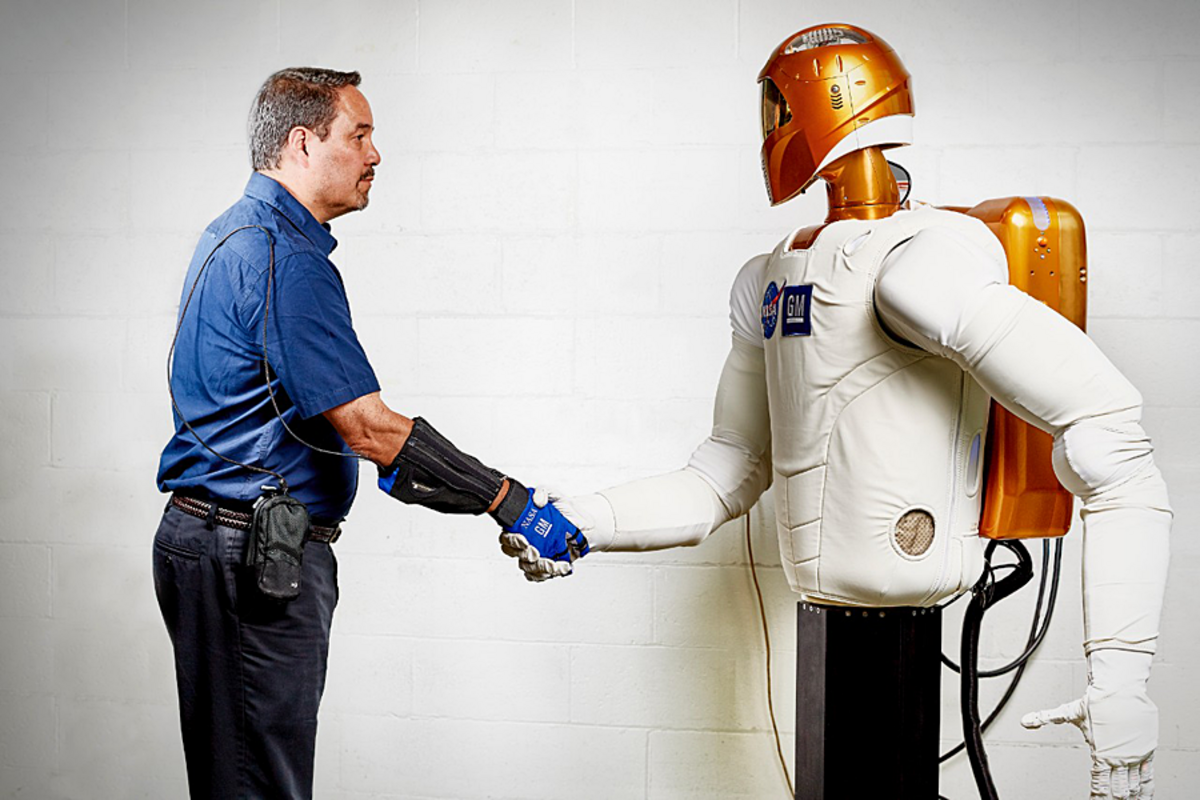How a bionic glove could help factory workers come to grips with robots
Loading...
A bionic glove for assembly line workers could stave off the robot takeover (for now).
The RoboGlove — designed a worker’s grip — is being developed by General Motors and Bioservo Technologies, a Swedish company that already produces exoskeletal-gloves for people with weaker grip due to injury. GM hopes to introduce a prototype of the RoboGlove to its factory floors next year, Alan Adler, a spokesperson for the automaker, tells ���Ǵ��� in a phone interview Wednesday.
The glove represents one of a number of emerging technologies aimed at enhancing humans’ dexterity, endurance, and strength so they can work alongside industrial robots. In fact, “co-robots” — the term for this symbiotic pairing — constitute the newest trend in this line of research, Ken Goldberg, a University of California, Berkeley professor in engineering and the director of the university’s People and Robots Initiative, tells the Monitor Wednesday.
“We don’t want to put humans out of work. We want to make them more efficient, more reliable, and less prone to injuries,” says Mr. Goldberg. “It’s about humans and robots working together.”
Initially developed through a collaborative effort between GM and NASA for astronauts to use outside the International Space Station (ISS), the RoboGlove aims to overcome normal muscle fatigue. The Earth version is fashioned after a human hand, with artificial muscles, tendons, and nerves. Its tendons retract into the glove, forcing it to grip, explains CNET’s Andrew Krok, and it does so without straining a user’s grip. To unloosen the glove’s hold, one only has to open one's hand. Sensors in the glove’s fingertips activate it.
The glove, powered by a battery worn on a belt, allows a worker to screw, tighten, and grip auto parts almost endlessly, as to a press release shows. Without the glove, a worker’s grip could fatigue in minutes.
GM isn’t the only manufacturer interested in wearable robotics for its workers. In a video from , a team of workers wear exoskeletons — — which Mashable writes can reduce the strain of lifting a heavy object repeatedly could have on a worker’s back.
How manufacturers have started to introduce robots to factory floors is far different from the job loss predicted decades ago. In January 1984, at the start of the personal computer era, the cover of US News and World Report’s was In it, the magazine tried to predict how robots and computers would affect the future of jobs.
Indeed, in advanced economies including the United States, Japan, and Germany, many jobs that were repetitive or rote , Martin Ford, author of The New York Times bestseller “Rise of the Robots: Technology and the Threat of a Jobless Future,” told NPR in May 2015. In the United States, this was most prevalent in the auto industry, with 64 percent of all the country’s 237,400 industrial robots in auto parts and vehicle manufacturing, according to The Wall Street Journal.
But, in addition to the high price of industrial robots (up to $150,000 each), there are still technological limitations. For one, a robot has the “dexterity of ,” said Mr. Goldberg, in a forum Fortune magazine held in November 2015.
Robots, Goldberg explains to the Monitor, don’t adapt well to changing parts or conditions.
“That’s where a human helping guide a robot can be very valuable,” he says. “Workers have extremely fine-tuned perceptual skills.”
In fact, the union between man and machine has proven to be a boon for productivity. London’s Centre for Economic Policy Research found that from 1993 to 2007, robots increased labor productivity by 0.36 percent. Researchers found that in that same time period there was no correlation between productivity and job loss.
This trend could continue to hold true, as smaller, more skilled robots operate alongside assembly-line workers. Once caged because they were too dangerous to stand next to, industrial robots can now operate alongside workers. A co-robot factory floor is the direction GM is heading, says Mr. Adler.
“Clearly, our plant workforce is very skilled at what they do,” he says. “We’re taking the really dangerous and difficult jobs away from humans.”




